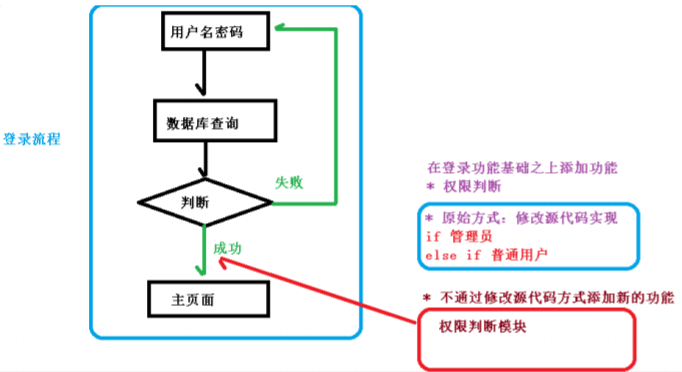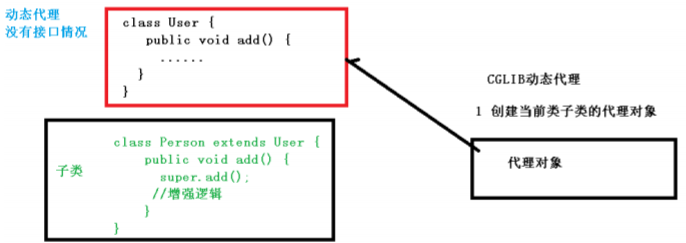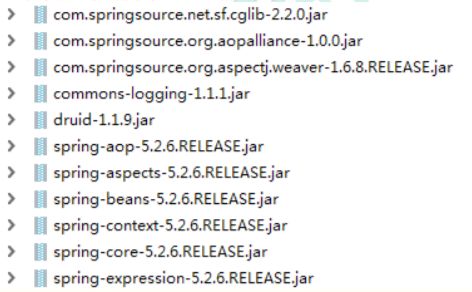AOP(概念)
什么是AOP
- AOP:面向切面编程,利用AOP可以对业务逻辑的各个部分进行隔离,从而使得业务逻辑部分之间的耦合度,提高程序的可重用性,同时提高了开发的效率
- 通俗描述:不通过修改源代码方式,在主干功能里边添加新功能。
- 使用登录例子说明AOP

AOP(底层原理)
AOP底层使用动态代理
有两种情况动态代理
第一种,有接口情况,使用JDK动态代理
- 创建接口实现类代理对象,增强类的方法

第二种,没有接口情况,使用CGLIB动态代理
- 创建子类的代理对象,增强类的方法

AOP(JDK动态代理)
使用JDK动态代理,使用Proxy类里面的方法创建代理对象

- 调用newProxyInstance方法

方法有三个参数:
- 第一个参数,类加载器
- 第二个参数,增强方法所在的类,这个类实现的接口,支持多个接口。
- 第三个参数,实现这个接口InvocationHandler,创建代理对象,写增强的部分。
编写JDK动态代理代码
创建接口,定义方法 ```java public interface UserDao {
public int add(int a, int b);
public String update(String id);
}
2. 创建接口实现类,实现方法
```java
public class UserDaoImpl implements UserDao {
public int add(int a, int b) {
return a + b;
}
public String update(String id) {
return id;
}
}
使用Proxy类创建接口代理对象 ```java public class JDKProxy {
public static void main(String[] args) {
// 创建接口实现类代理对象 Class[] interfaces = {UserDao.class}; //Proxy.newProxyInstance(JDKProxy.class.getClassLoader(), interfaces, new InvocationHandler() { // public Object invoke(Object proxy, Method method, Object[] args) throws Throwable { // return null; // } //}); UserDao userDao = new UserDaoImpl(); UserDao userDao1 = (UserDao) Proxy.newProxyInstance(JDKProxy.class.getClassLoader(), interfaces, new UserDaoProxy(userDao)); System.out.println("执行结果" + userDao1.add(1, 2));}
}
// 创建代理对象的方法 class UserDaoProxy implements InvocationHandler{ // 1. 把创建的是谁的代理对象,把谁传递过来 // 有参构造 private Object obj;
public UserDaoProxy(Object obj) {
this.obj = obj;
}
// 增强业务的逻辑
@Override
public Object invoke(Object proxy, Method method, Object[] args) throws Throwable {
// 方法之前
System.out.println("方法执行之前执行...." + method.getName() + " ....传递的而参数" + Arrays.toString(args));
// 被增强的方法执行
Object res = method.invoke(obj, args);
// 方法执行之后执行
System.out.println("方法执行之后输出。。。" + obj);
return res;
}
}
<a name="c371280e"></a>
# AOP(术语)
1. 连接点
- 类里面哪些方法可以被增强,这些方法称为连接点
2. 切入点
- 实际被真正增强的方法,称为切入点
3. 通知(增强)
1. 实际增强的部分被称为通知(增强)
1. 通知有多种类型
- 前置通知
- 后置通知
- 环绕通知
- 异常通知
- 最终通知
4. 切面
- 是动作,把通知应用到切入点过程
<a name="c2f815d8"></a>
# AOP操作(准备工作)
<a name="521b6839"></a>
## Spring框架一般都是基于AspectJ实现AOP操作
1. AspectJ不是Spring组成部分,独立AOP框架,一般把AspectJ和Spring框架一块儿使用,进行AOP操作。
<a name="3bb9cf0d"></a>
## 基于AspectJ实现AOP操作
1. 基于xml注解方式实现
1. 基于注解方式实现(使用)
<a name="fb70084a"></a>
## 在项目工程里面引入AOP相关依赖

<a name="d0b355ed"></a>
## 切入点表达式
1. 切入点表达式作用:知到对哪个类里面的方法进行增强
1. 语法结构:`execution([权限修饰符][返回类型][类全路径][方法名称]([参数列表]))`
1. 举例1:对com.zh.dao.BookDao类里面的add进行增强,`execution(* com.zh.dao.BookDao.add(..))`
1. 举例2:对com.zh.dao.BookDao类里面所有的方法及逆行增强,`execution(* com.zh.dao.BookDao.*(..))`
1. 举例3:对com.zh.dao包里面所有类,类的所有方法进行增强,`execution(* com.zh.dao.*.*(..))`
<a name="8fb45eef"></a>
# AOP操作(AspectJ注解)
<a name="da6da3bc"></a>
## 创建类,在类里面定义方法
```java
public class User {
public void add() {
System.out.println("User.add");
}
}
创建增强类(编写增强逻辑)
public class UserProxy {
public void before() {
System.out.print("UserProxy.brfore");
}
}
进行通知的配置
在spring配置文件中,开启注解扫描
<beans xmlns="http://www.springframework.org/schema/beans"
xmlns:xsi="http://www.w3.org/2001/XMLSchema-instance"
xmlns:context="http://www.springframework.org/schema/context"
xmlns:aop="http://www.springframework.org/schema/aop"
xsi:schemaLocation="http://www.springframework.org/schema/beans http://www.springframework.org/schema/beans/spring-beans.xsd
http://www.springframework.org/schema/context http://www.springframework.org/schema/context/spring-context.xsd
http://www.springframework.org/schema/aop http://www.springframework.org/schema/aop/spring-aop.xsd">
<!--开启注解的扫描-->
<context:component-scan base-package="com.zh.spring5.aopanno"></context:component-scan>
使用注解创建User和UserProxy对象
@Component
public class User {
public void add() {
System.out.println("User.add");
}
}
@Component
public class UserProxy {
public void before() {
System.out.print("UserProxy.brfore");
}
}
在增强类上面添加注解@Aspect
@Component
@Aspect // 生成代理对象
public class UserProxy {
在spring配置文件中开启生成代理对象
<!--生成Aspect生成代理对象-->
<aop:aspectj-autoproxy></aop:aspectj-autoproxy>
配置不同类型的通知
@Component
@Aspect // 生成代理对象
public class UserProxy {
// 前置通知
// @Before注解表示作为前置通知
@Before(value = "execution(* com.zh.spring5.aopanno.User.add(..))")
public void before() {
System.out.println("UserProxy.before");
}
// 最终通知
@After(value = "execution(* com.zh.spring5.aopanno.User.add(..))")
public void after() {
System.out.println("UserProxy.after");
}
// 返回通知(返回通知)
@AfterReturning(value = "execution(* com.zh.spring5.aopanno.User.add(..))")
public void afterReturning() {
System.out.println("UserProxy.afterReturning");
}
// 异常通知
@AfterThrowing(value = "execution(* com.zh.spring5.aopanno.User.add(..))")
public void afterThrowing() {
System.out.println("UserProxy.afterThrowing");
}
// 环绕通知
@Around(value = "execution(* com.zh.spring5.aopanno.User.add(..))")
public void around(ProceedingJoinPoint proceedingJoinPoint) throws Throwable {
System.out.println("UserProxy.around之前");
// 被增强的方法执行
proceedingJoinPoint.proceed();
System.out.println("UserProxy.around之后");
}
}
相同的接入点的抽取
@Component
@Aspect // 生成代理对象
public class UserProxy {
// 相同切入点抽取
@Pointcut(value = "execution(* com.zh.spring5.aopanno.User.add(..))")
public void pointDemo() {
}
// 前置通知
// @Before注解表示作为前置通知
@Before(value = "pointDemo()")
public void before() {
System.out.println("UserProxy.before");
}
}
有多个增强类多同一个方法进行增强,设置增强类优先级
- 在增强类上面添加注解==@Order(数字类型值)==,数字类型值越小优先级越高
@Component
@Aspect
@Order(1)
public class PersonProxy {
完全使用注解开发
创建配置类,不需要创建xml配置文件
@Configuration
@ComponentScan(basePackages = {"com.zh"})
@EnableAspectJAutoProxy(proxyTargetClass = true)
public class ConfigAop {
}
AOP操作(AspectJ配置文件)
创建两个类,增强类和被增强类,创建方法
在Spring配置文件中创建两个类对象
<!--创建对象-->
<bean id="book" class="com.zh.spring5.aopxml.Book"></bean>
<bean id="bookProxy" class="com.zh.spring5.aopxml.BookProxy"></bean>
在Spring配置文件中配置切入点
<!--配置AOP增强-->
<aop:config>
<!--切入点-->
<aop:pointcut id="p" expression="execution(* com.zh.spring5.aopxml.Book.buy(..))"/>
<!--配置切面-->
<aop:aspect ref="bookProxy">
<!--增强作用在具体的方法上-->
<aop:before method="before" pointcut-ref="p"></aop:before>
</aop:aspect>
</aop:config>

